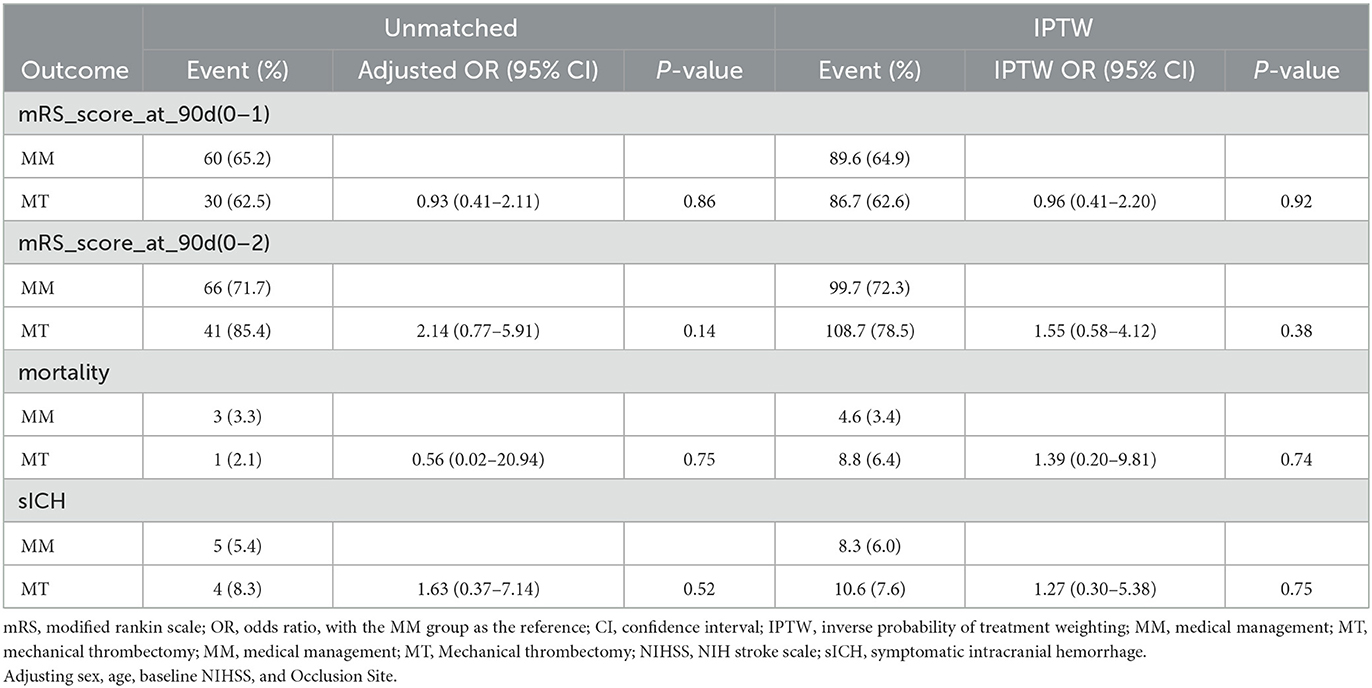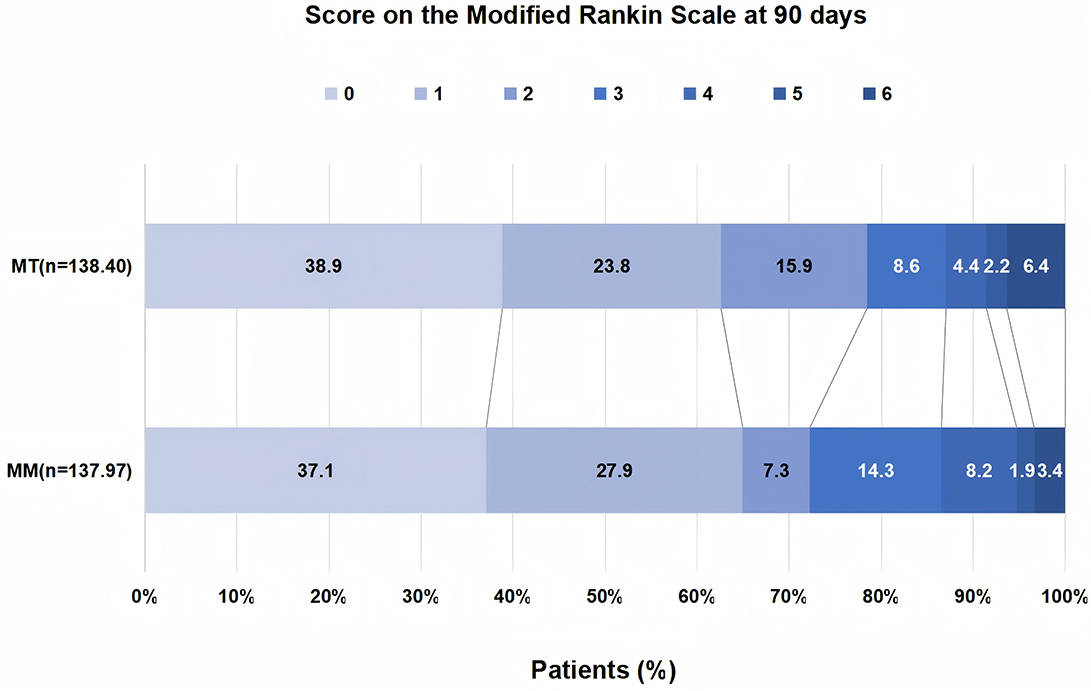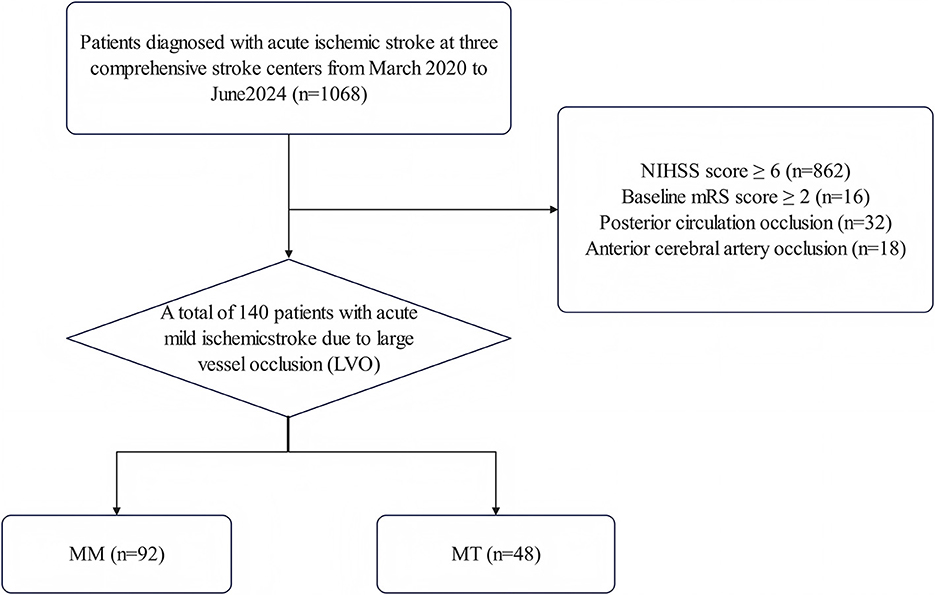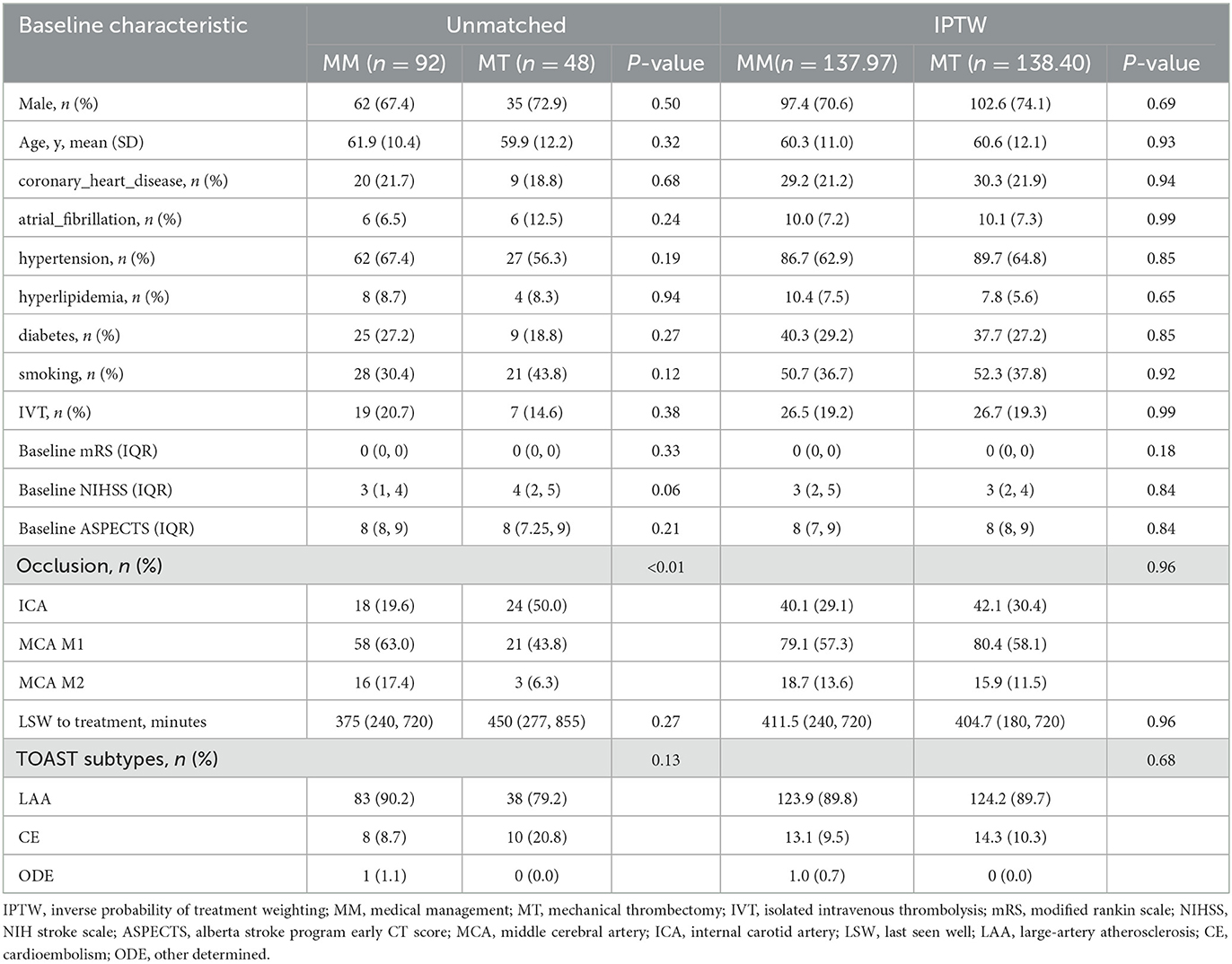- 1Department of Neurology, Xianyang Hospital of Yan'an University, Xianyang, China
- 2Department of Neurosurgery, The First Hospital of Yulin and The Second Affiliated Hospital, Yan'an University, Yulin, China
- 3School of Clinical Medicine, Xi'an Medical University, Xi'an, China
Background: The clinical benefit of mechanical thrombectomy (MT) for anterior circulation emergency large vessel occlusion (ELVO) in patients presenting with a mild National Institutes of Health Stroke Scale score (<6) remains uncertain. We aimed to assess the efficacy and safety of MT in this patient population.
Methods: We enrolled individuals presenting with mild stroke attributable to anterior circulation LVO from three stroke centers between March 2020 and June 2024. The primary endpoint was an excellent 90-day outcome, defined as a modified Rankin Scale (mRS) score of 0–1. Functional independence at day 90 (mRS 0–2) was considered the secondary endpoint. Safety endpoints consisted of symptomatic intracranial hemorrhage (sICH) and all-cause mortality within 90 days. Multivariable logistic regression with inverse probability of treatment weighting (IPTW) was applied to examine the association between MT and clinical outcomes.
Results: In total, 140 individuals with mELVO were selected for analysis, receiving either MT [n = 48; 35 males; mean age: 59.9 years; NIHSS median: 4 (IQR 2–5)] or medical management (MM) [n = 92; 62 males; mean age: 61.9 years; NIHSS median: 3 (IQR 1–4)]. No statistically significant differences were observed between the MT and MM groups in excellent outcome (aOR = 0.93; 95% CI, 0.41–2.11), functional independence (aOR = 2.14; 95% CI, 0.77–5.91), symptomatic intracranial hemorrhage (aOR = 1.63; 95% CI, 0.37–7.14), or mortality (aOR = 0.56; 95% CI, 0.02–20.94). The results remained consistent after IPTW adjustment.
Conclusion: Among patients with mELVO, MT was not associated with significantly different outcomes compared to MM. Further investigation through randomized controlled trials is warranted.
Introduction
Several randomized controlled studies have been demonstrated that mechanical thrombectomy (MT) leads to improved neurological outcomes in patients with anterior circulation emergency large vessel occlusion (ELVO), compared to medical management (MM) (1–4). As such, the American Heart Association (AHA) recommends that MT be considered the recommended treatment for anterior circulation ELVO and National Institutes of Health Stroke Scale (NIHSS) scores of at least 6 (5, 6). Patients with ELVO with a NIHSS < 6 (mELVO) were commonly excluded from these trials, with only three studies including a limited number of patients with mild neurological deficits (7–9).
As many as 10% of patients with ELVO demonstrate only minor stroke symptoms (10–12). Approximately 25% of patients with low-NIHSS ELVO stroke who received medical management did not achieve functional independence at 3 months (13). Only a small proportion of those receiving intravenous thrombolysis (IVT) achieved successful recanalization (14). A considerable number of patients with mild ELVO stroke may still experience poor clinical outcomes. Therefore, MT might offer greater functional benefit for individuals presenting with mild neurological symptoms.
Evidence supporting the clinical benefit and risks of MT in this specific subgroup remains limited. Therefore, we performed a multicenter retrospective study to assess the safety and efficacy outcomes of MT or MM in patients with mELVO.
Methods
Study participants
Between March 2020 and June 2024, individuals with mELVO who met the following criteria were identified from individuals admitted to three stroke centers:(1) age ≥ 18 years;(2) anterior circulation ELVO (internal carotid artery, M1 middle cerebral artery, and M2 middle cerebral artery) received treatment within 24 h after symptom emergence; (3) baseline NIHSS below 6. Patient data were retrieved via the hospital's electronic record system. For those undergoing MT, the preprocedural NIHSS score was applied; for MM patients, the admission score was used. Patients who had an NIHSS score of ≤ 5 at admission but experienced clinical deterioration resulting in a preprocedural NIHSS score >5 and subsequently underwent MT were removed from analysis. The MM group comprised patients who received either IVT alone or conservative treatment, whereas the MT group included those treated with MT alone or with bridging IVT. Patients with incomplete baseline data were excluded from the statistical analysis.
Study treatments and interventions
We collected baseline data including age, sex, history of hypertension, diabetes, hyperlipidemia, atrial fibrillation, coronary artery disease, smoking status, Alberta Stroke Program Early Computed Tomography (CT) Score, modified Rankin Scale (mRS) and NIHSS scores at admission, site of vessel occlusion, IVT, and the time from last seen well to treatment.
Outcomes measures
We evaluated the following efficacy outcomes: the primary end point was 90-day excellent outcome (defined as mRS score of 0–1). The secondary end point was 90-day functional independence (defined as mRS score of 0–2). Safety outcomes included 90-day mortality and symptomatic intracranial hemorrhage (sICH) (15). The mRS at 90 days was evaluated by study personnel through face-to-face or telephone follow-up.
Statistical analysis
Normality of continuous variables was assessed using the Shapiro–Wilk test. Data that were normally distributed were summarized as mean (SD), while non-normally distributed data were reported as median and interquartile range (IQR). Categorical data were expressed as proportions (%). Group differences in continuous variables were analyzed using the Wilcoxon-Mann-Whitney test, and categorical data were examined using either the chi-square or Fisher exact test, depending on applicability. In addition, inverse probability of treatment weighting (IPTW) was applied to balance baseline differences between the two groups. To evaluate covariate balance after weighting, we calculated standardized mean differences (SMD), considering values below 0.20 as acceptable.
Additionally, multivariable logistic regression was performed with adjustment for sex, age, baseline NIHSS score, and occlusion site to estimate adjusted odds ratios (aORs) with 95% confidence intervals (CIs). The relationship between MT and clinical outcomes was assessed using logistic regression adjusted with IPTW.
Subgroup analyses
To explore the potential heterogeneity in treatment efficacy across different treatment windows, patients were stratified into early (≤6 h) and late (6–24 h) subgroups. Multivariable logistic regression was used, adjusting for sex, age, baseline NIHSS score, and occlusion site.
IBM SPSS Statistics 27.0 (IBM Corp., Armonk, NY) was used for general statistical analysis, and RStudio software (version 4.4.3) was applied for building and evaluating the IPTW model. Statistical significance was determined using a two-sided threshold of P < 0.05.
Results
Baseline characteristic
A total of 140 patients with mELVO were included based on established selection criteria. The study flowchart is presented in Figure 1. 48 patients were treated with MT [mean (SD) age, 59.9 (12.2) years; 72.9% male; median NIHSS 4 (IQR 2–5)], and 92 received MM [mean (SD) age, 61.9 (10.4) years; 67.4% male; median NIHSS 3 (IQR 1–4)]. Baseline variables for the MT and MM groups are summarized in Table 1. Compared to MM, MT showed a greater proportion of internal carotid artery (ICA) occlusions (50% vs. 19.6%) and lower proportions of MCA-M1 (43.8% vs. 63%) and MCA-M2 (6.3% vs. 17.4%) occlusions (P < 0.01). The MT group showed a numerically higher baseline NIHSS score [4 (IQR, 2–5) vs. 3 (IQR, 1–4); P = 0.06]. Baseline covariates were balanced between the groups following IPTW adjustment.
Clinical outcomes
The distribution of clinical outcomes between MT and MM is shown in Table 2. The two groups showed comparable results with respect to 3-month excellent outcome (62.5% vs. 65.2%, P = 0.75) or functional independence at 3 months (85.4% vs. 71.7%, P = 0.07; Table 2). Additionally, the incidence of sICH was numerically higher in the MT group (8.3% vs. 5.4%, P = 0.51), but the difference did not reach statistical significance. Mortality rates were low in both groups (2.1% vs. 3.3%, P = 0.68). Consistent outcomes were obtained in the IPTW-adjusted model (Table 2, Figure 2).

Table 2. Clinical Outcomes and the Association With Mechanical Thrombectomy in Patients With Low NIHSS Scores.

Figure 2. Distribution of 90-day modified rankin scale (mRS) scores based on the IPTW-adjusted cohort. MM, medical management; MT, Mechanical thrombectomy.
In the multivariable analysis adjusted for covariates (Table 2), the two groups showed comparable rates of excellent outcome (aOR = 0.93; 95% CI, 0.41–2.11; P = 0.86) and functional independence (aOR = 2.14; 95% CI, 0.77–5.91; P = 0.14). Consistent results were observed in the IPTW analysis, which also showed no significant differences in excellent outcomes (IPTW-adjusted OR = 0.96; 95% CI, 0.41–2.20; P = 0.92) or functional independence (IPTW-adjusted OR = 1.55; 95% CI, 0.58–4.12; P = 0.38).
The rates of sICH (aOR = 1.63; 95% CI, 0.37–7.14; P = 0.52; IPTW-adjusted OR = 1.27; 95% CI, 0.30–5.38; P = 0.75) and mortality (aOR = 0.56; 95% CI, 0.02–20.94; P = 0.75; IPTW-adjusted OR = 1.39; 95% CI, 0.20–9.81; P = 0.74) were not significantly different between the two groups in both the covariate-adjusted and IPTW-adjusted analyses.
Subgroup analyses
Further analysis revealed that, after stratification by time window, no significant association was observed between MT and excellent outcome in either the early window (aOR = 0.52; 95% CI, 0.14–1.94; P = 0.33) or the late window (aOR = 1.62; 95% CI, 0.45–5.87; P = 0.46; Table 3).

Table 3. Excellent outcome rates (mRS 0–1) and unadjusted vs. adjusted odds ratios between MT and MM, stratified by treatment time window.
Discussion
Among patients with anterior circulation ELVO and low NIHSS scores, our analysis showed comparable rates of excellent outcomes (62.5% vs. 65.2%) and functional independence (85.4% vs. 71.7%) between the MT and MM groups. Moreover, MT was not associated with higher rates of sICH or mortality at 90 days. The IPTW-adjusted analysis confirmed this finding.
A multicenter study was conducted to compare MT (n = 202) and MM (n = 116) in the treatment of patients with mELVO (16). They found that, compared with MM, MT was associated with similar rates of excellent outcomes at 90 days (aOR = 0.86; 95% CI, 0.49–1.50; P = 0.59) and functional independence (aOR = 0.72; 95% CI, 0.35–1.50; P = 0.39). Likewise, there were no statistically significant differences in the risks of intracranial hemorrhage or mortality. These results are consistent with our findings. However, in contrast to their study, which included patients with a prestroke mRS score of ≤ 4, our study restricted enrollment to mELVO patients with a prestroke mRS score of < 2. Our findings are consistent with those reported by Sarraj et al. (17), who observed favorable outcomes in 55.7% and independent outcomes in 63.3% of patients treated with MT. Compared with MM, MT did not demonstrate a significant clinical advantage. Similarly, a multicenter observational study and meta-analysis involving 251 patients reported that mechanical thrombectomy was associated with functional outcomes comparable to those of medical management (MM) in patients with mild stroke (NIHSS < 6) (18). Moreover, the meta-analysis suggested that the difference in symptomatic intracranial hemorrhage disappeared after adjusting for confounding factors (adjusted OR = 2.89; P = 0.12).
Additionally, no significant association was observed between MT and favorable 90-day functional outcomes among patients in the late treatment window relative to the early window (aOR = 1.62; 95% CI, 0.45–5.87; P = 0.46). Evidence suggests that nearly 60% of patients with ELVO and mild stroke face a high risk of neurological deterioration within 6 h of onset (19). Although our data may suggest that the efficacy of mechanical thrombectomy (MT) in the late time window may not differ significantly from the early time window (Table 3), this finding must be interpreted with caution. The exclusion of patients with neurological deterioration within 6 h in the early time window could lead to an underestimation of the treatment effect. Additionally, in the late time window, the lack of intravenous thrombolysis may result in poorer outcomes, further highlighting the importance of future studies to assess the true impact of delayed treatment on MT efficacy.
Our study included more cases of proximal intracranial occlusions (ICA and MCA-M1). Theoretically, neurological deterioration may be more common in patients with proximal anterior circulation occlusions (20). MT offers prompt and reliable restoration of vessel patency. The potential benefit of MT may have been attenuated by well-compensated collateral circulation in mELVO patients; however, this remains a hypothesis, as collateral status was not evaluated in the present study.
Even though MT was not significantly associated with improved outcomes at 3 months, the possibility of meaningful benefit in specific patient subgroups cannot be excluded. For instance, in patients with imaging evidence of a substantial volume of salvageable ischemic tissue, MT may improve clinical outcomes under specific conditions (21, 22). Future studies should perform stratified analyses to better determine the therapeutic efficacy of MT across relevant patient subgroups.
This study has several limitations. First, this was a retrospective study. Despite using methods like propensity score adjustment to minimize confounding, the influence of unmeasured or unknown confounders cannot be entirely excluded. Thus, the results should be interpreted cautiously. Second, a key limitation of this study is its relatively small sample size (n = 140), which may have limited the statistical power to detect significant associations between treatment modality and clinical outcomes. For instance, due to the small number of patients with M2 occlusions, we were unable to conduct detailed stratified analyses by occlusion location, which may have limited the depth of our interpretation. Second, as complete imaging data were not available for all patients, this study was unable to systematically assess collateral status, which limited further exploration of its role in disease progression and prognosis. Future studies incorporating collateral status evaluation could provide additional insights into the impact of collateral circulation on treatment outcomes. Third, NIHSS may not adequately reflect the stroke severity in patients with mild symptoms. Certain deficits such as aphasia or hemianopia can be highly disabling, whereas others like mild facial palsy or slight dysarthria may have minimal functional impact. Treatment decisions and prognostic evaluations could be influenced by this heterogeneity. Fourth, the mRS score, while commonly used to assess functional outcomes, may fail to capture subtle improvements in fine motor or language function among mELVO patients. Future studies may consider using the Barthel Index for a more granular evaluation of 3-month functional independence. Further randomized controlled trials are warranted to establish the safety and efficacy of MT compared to MM in patients with mELVO.
Conclusions
In conclusion, our multicenter study showed no significant functional or safety benefit of MT in patients with LVO and low NIHSS scores. Future randomized clinical trials are warranted to assess the clinical benefit of mechanical thrombectomy (MT) compared with medical management (MM) in patients with mELVO.
Data availability statement
The datasets presented in this article are not readily available because the data that support the findings of this study are not publicly available but are available from the corresponding author or data sharing committee upon reasonable request. Requests to access the datasets should be directed to Gaopan Zhang, Z2FvcGFuemhhbmcxMjNAc2luYS5jb20=.
Ethics statement
The studies involving humans were approved by Yan'an University Xianyang Hospital. The studies were conducted in accordance with the local legislation and institutional requirements. The participants provided their written informed consent to participate in this study.
Author contributions
GZ: Formal analysis, Conceptualization, Data curation, Writing – original draft, Investigation, Funding acquisition. NZ: Conceptualization, Validation, Methodology, Data curation, Writing – review & editing, Visualization, Software, Project administration. JL: Software, Supervision, Investigation, Writing – review & editing, Data curation. SZ: Writing – review & editing, Project administration, Formal analysis. ML: Data curation, Writing – review & editing. XZ: Project administration, Writing – review & editing, Supervision, Conceptualization, Investigation, Funding acquisition, Resources.
Funding
The author(s) declare that financial support was received for the research and/or publication of this article. This study was supported by the General Project of the Special Fund of Yan'an University Xianyang Hospital [Project Number: 2025KY015].
Conflict of interest
The authors declare that the research was conducted in the absence of any commercial or financial relationships that could be construed as a potential conflict of interest.
Generative AI statement
The author(s) declare that no Gen AI was used in the creation of this manuscript.
Any alternative text (alt text) provided alongside figures in this article has been generated by Frontiers with the support of artificial intelligence and reasonable efforts have been made to ensure accuracy, including review by the authors wherever possible. If you identify any issues, please contact us.
Publisher's note
All claims expressed in this article are solely those of the authors and do not necessarily represent those of their affiliated organizations, or those of the publisher, the editors and the reviewers. Any product that may be evaluated in this article, or claim that may be made by its manufacturer, is not guaranteed or endorsed by the publisher.
References
1. Saver JL, Goyal M, Bonafe A, Diener H-C, Levy E-I, Pereiraet VM, et al. Stent-retriever thrombectomy after intravenous t-PA vs. t-PA alone in stroke. N Engl J Med. (2015) 372:2285–95. doi: 10.1056/NEJMoa1415061
2. Goyal M, Demchuk AM, Menon BK, Eesa M, Rempel JL, Thornton, et al. Randomized assessment of rapid endovascular treatment of ischemic stroke. N Engl J Med. (2015) 372:1019–30. doi: 10.1056/NEJMoa1414905
3. Jovin TG, Chamorro A, Cobo E, de Miquel MA, Molina CA, Rovira A, et al. Thrombectomy within 8 hours after symptom onset in ischemic stroke. N Engl J Med. (2015) 372:2296–306. doi: 10.1056/NEJMoa1503780
4. Albers GW, Marks MP, Kemp S, Christensen S, Tsai JP, Ortega-Gutierrez S, et al. Thrombectomy for stroke at 6 to 16 hours with selection by perfusion imaging. N Engl J Med. (2018) 378:708–18. doi: 10.1056/NEJMoa1713973
5. Powers WJ, Rabinstein AA, Ackerson T, Adeoye OM, Bambakidis NC, Becker K, et al. Guidelines for the early management of patients with acute ischemic stroke: 2019 update to the 2018 guidelines for the early management of acute ischemic stroke: a guideline for healthcare professionals from the American Heart Association/American Stroke Association. Stroke. (2019) 50:e344–418. doi: 10.1161/STR.0000000000000211
6. Turc G, Bhogal P, Fischer U, Khatri P, Lobotesis K, Mazighi M, et al. European Stroke Organisation (ESO) - European society for minimally invasive neurological therapy (ESMINT) guidelines on mechanical thrombectomy in acute ischaemic strokeendorsed by stroke alliance for Europe (SAFE). Eur Stroke J. (2019) 4:6–12. doi: 10.1177/2396987319832140
7. Berkhemer OA, Fransen PS, Beumer D, van den Berg LA, Lingsma HF, Hofmeijer J. A randomized trial of intraarterial treatment for acute ischemic stroke. N Engl J Med. (2015) 372:11–20. doi: 10.1056/NEJMx140064
8. Olthuis SGH, Pirson FAV, Pinckaers FME, Hinsenveld WH, Nieboer D, Ceulemans A, et al. Endovascular treatment versus no endovascular treatment after 6–24 h in patients with ischaemic stroke and collateral flow on CT angiography (MR CLEAN-LATE) in the Netherlands: a multicentre, open-label, blinded-endpoint, randomised, controlled, phase 3 trial. Lancet. (2023) 401:1371–80. doi: 10.1016/S0140-6736(23)00575-5
9. Campbell BC, Mitchell PJ, Kleinig TJ, Dewey HM, Churilov L, Yassi N, et al. Endovascular therapy for ischemic stroke with perfusion-imaging selection. N Engl J Med. (2015) 372:1009–18. doi: 10.1056/NEJMoa1414792
10. Rai AT, Seldon AE, Boo S, Link PS, Domico JR, Tarabishy AR, et al. A population-based incidence of acute large vessel occlusions and thrombectomy eligible patients indicates significant potential for growth of endovascular stroke therapy in the USA. J Neurointerv Surg. (2017) 9:722–6. doi: 10.1136/neurintsurg-2016-012515
11. Scheitz JF, Abdul-Rahim AH, MacIsaac RL, Cooray C, Sucharew H, Kleindorfer D, et al. Clinical selection strategies to identify ischemic stroke patients with large anterior vessel occlusion: results from SITS-ISTR (safe Implementation of thrombolysis in stroke international stroke thrombolysis registry). Stroke. (2017) 48:290–7. doi: 10.1161/STROKEAHA.116.014431
12. Fischer U, Arnold M, Nedeltchev K, Brekenfeld C, Ballinari P, Remonda L, et al. NIHSS score and arteriographic findings in acute ischemic stroke. Stroke. (2005) 36:2121–5. doi: 10.1161/01.STR.0000182099.04994.fc
13. Kim JT, Park MS, Chang J, Lee JS, Choi KH, Cho KH. Proximal arterial occlusion in acute ischemic stroke with low NIHSS scores should not be considered as mild stroke. PLoS ONE. (2013) 8:e70996. doi: 10.1371/journal.pone.0070996
14. Haussen DC, Bouslama M, Grossberg JA, Anderson A, Belagage S, Frankel M, et al. Too good to intervene? Thrombectomy for large vessel occlusion strokes with minimal symptoms: an intention-to-treat analysis. J Neurointerv Surg. (2017) 9:917–21. doi: 10.1136/neurintsurg-2016-012633
15. Hacke W, Kaste M, Bluhmki E, Brozman M, Dávalos A, Guidetti D, et al. Thrombolysis with alteplase 3 to 45 hours after acute ischemic stroke. N Engl J Med. (2008) 359:1317–29. doi: 10.1056/NEJMoa0804656
16. Marto JP, Qureshi M, Nagel S, Nogueira RG, Henon H, Tomppo L, et al. Endovascular therapy for patients with low NIHSS scores and large vessel occlusion in the 6– to 24–hour window: analysis of the CLEAR study. Neurology. (2025) 104:e213442. doi: 10.1212/WNL.0000000000213442
17. Sarraj A, Hassan A, Savitz SI, Grotta JC, Cai C, Parsha KN, et al. Endovascular thrombectomy for mild strokes: how low should we go? Stroke. (2018) 49:2398–405. doi: 10.1161/STROKEAHA.118.022114
18. Goyal N, Tsivgoulis G, Malhotra K, et al. Medical management vs mechanical thrombectomy for mild strokes: an international multicenter study and systematic review and meta-analysis. JAMA Neurol. (2020) 77:16–24.
19. Seners P, Ben Hassen W, Lapergue B, Arquizan C, Heldner MR, Henon H, et al. Prediction of early neurological deterioration in individuals with minor stroke and large vessel occlusion intended for intravenous thrombolysis alone. JAMA Neurol. (2021) 78:321–8. doi: 10.1001/jamaneurol.2020.4557
20. Coutts SB, Ankolekar S, Appireddy R, Arenillas JF, Assis Z, Bailey P, et al. Tenecteplase versus standard of care for minor ischaemic stroke with proven occlusion (TEMPO-2): a randomised, open label, phase 3 superiority trial. Lancet. (2024) 403:2597–605. doi: 10.1016/S0140-6736(24)00921-8
21. Sarraj A, Albers GW, Blasco J, Arenillas JF, Ribo M, Hassan AE, et al. Thrombectomy versus medical management in mild strokes due to large vessel occlusion: exploratory analysis from the EXTEND-IA trials and a pooled international cohort. Ann Neurol. (2022) 92:364–78. doi: 10.1002/ana.26418
Keywords: ischemic stroke, thrombectomy, intracranial hemorrhages, mortality, odds ratio
Citation: Zhang G, Zhang N, Li J, Zhang S, Li M and Zhao X (2025) Mechanical thrombectomy for mild stroke with anterior circulation large vessel occlusion: a multicenter cohort study. Front. Neurol. 16:1668704. doi: 10.3389/fneur.2025.1668704
Received: 18 July 2025; Accepted: 21 August 2025;
Published: 05 September 2025.
Edited by:
Chih-Hao Chen, National Taiwan University Hospital, TaiwanReviewed by:
Koji Tanaka, Fujita Health University, JapanTsang-Shan Chen, Sin-Lau Christian Hospital, Taiwan
Copyright © 2025 Zhang, Zhang, Li, Zhang, Li and Zhao. This is an open-access article distributed under the terms of the Creative Commons Attribution License (CC BY). The use, distribution or reproduction in other forums is permitted, provided the original author(s) and the copyright owner(s) are credited and that the original publication in this journal is cited, in accordance with accepted academic practice. No use, distribution or reproduction is permitted which does not comply with these terms.
*Correspondence: Xiongfei Zhao, Wmhhb3hpb25nZmVpMTk3M0BzaW5hLmNvbQ==
†These authors have contributed equally to this work and share first authorship
 Gaopan Zhang
Gaopan Zhang Neng Zhang1†
Neng Zhang1† Xiongfei Zhao
Xiongfei Zhao
